Mastering Customer Feedback for Business Growth
Mastering Customer Feedback for Business Growth
Mastering Customer Feedback for Business Growth
Get a free customer feedback sample to see how to ask the right questions & gain valuable insights.
Get a free customer feedback sample to see how to ask the right questions & gain valuable insights.
Get a free customer feedback sample to see how to ask the right questions & gain valuable insights.



The hyper-competitive business landscape that we see today makes understanding your customers a necessity. Did you know that a staggering 83% of customers feel more loyal to brand that listens to their feedback and also resolves them!
This good customer service turns one-time clients into long-term brand champions. So yes! Customer experience (CX) is indeed a key differentiator.
But how can you truly understand your customers and what they want if you're not listening to them? That's where customer feedback comes in.
Customer feedback is the gold mine of insights businesses can leverage to refine their products and services, improve customer satisfaction, and ultimately boost their bottom line.
By actively soliciting and analyzing customer feedback, you gain a window into their perceptions of your brand, what they love about your offerings, and where there's room for improvement. Think of it as a direct line of communication with your most valuable asset: your customers!
Understanding Different Types of Customer Feedback
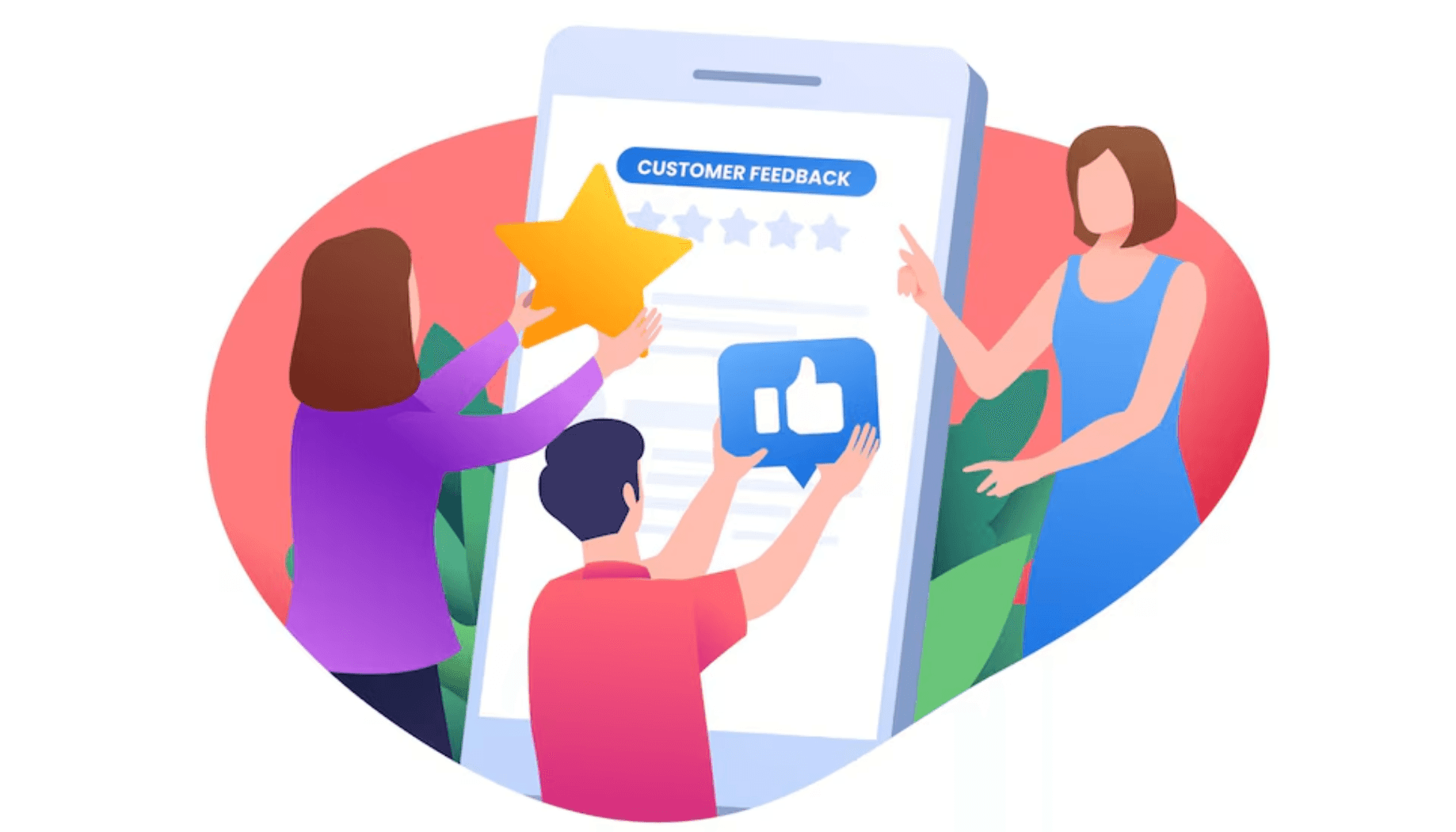
Customer feedback comes in all shapes and sizes, from glowing online reviews to frustrated emails to your support team. But not all feedback holds the same weight. There are three main types of customer feedback and here’s how you can turn them into actionable insights.
Positive Feedback
These are the happy customers who rave about your product or service. According to a study, a highly satisfied customer tells an average of 9 people about their positive experience. Positive feedback validates what you're doing right and can inspire you to keep innovating.
But don't just bask in the praise! Look for opportunities to learn more about what these customers love. Are they particularly impressed with a specific feature? Knowing this can help you tailor your marketing messages to resonate with a wider audience.
Negative Feedback (Turning Criticism into Improvement)
Let's face it, negative feedback can sting. But before you hit delete, consider this: after just one bad experience, a whopping 80% of consumers say they'd rather do business with a competitor. That's a harsh reality, but it highlights the importance of listening to criticism and using it to improve.
Negative feedback, while unpleasant, is a goldmine for improvement. It pinpoints areas where your product or service is falling short and gives you a chance to address customer concerns before they snowball.
Neutral Feedback: Identifying Areas for Differentiation
Neutral feedback can be a bit trickier to decipher. These customers might not be unhappy, but they're not exactly jumping for joy either. The key here is to listen closely to their lukewarm response.
Are they suggesting alternative features?
Do they seem confused about how to use your product?
Neutral feedback can highlight areas where you can differentiate yourself from the competition and provide a more compelling customer experience.
So, you're convinced of the power of customer feedback. Now comes the question: how do you actually get your customers to share their thoughts? Here's where strategy comes into play.
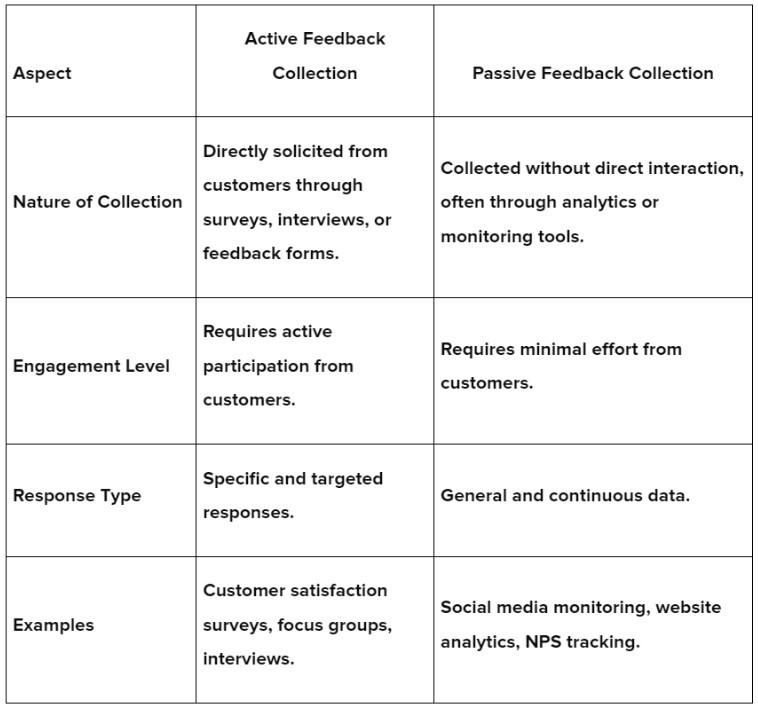
Best Practices in Customer Feedback Collection
We've established that customer feedback is crucial for improving your product or service and keeping customers happy.
But how do you effectively collect this valuable feedback?
Here are some best practices to ensure you're getting the most out of your customer feedback collection efforts,
Leveraging Multiple Channels
Customers today have a multitude of ways to interact with brands. To capture the most comprehensive feedback, it's crucial to cast a wide net and provide multiple channels for them to express themselves. Here are some popular options:
Online Reviews: Sites like Google Reviews and Yelp have become powerful platforms for customer feedback. Did you know that 93% of consumers read online reviews before purchasing? Encouraging satisfied customers to leave positive reviews can significantly boost your brand reputation and attract new customers.
Surveys: Surveys are a versatile tool for gathering specific feedback on your product, service, or customer experience. Email, SMS, and even in-app surveys allow you to target specific customer segments and ask targeted questions.
Pro tip: Keep surveys concise and easy to complete – no one wants to spend 15 minutes filling out a questionnaire!
Social Media Interactions: Social media platforms are a goldmine for real-time customer feedback. People increasingly use Twitter, Facebook, and Instagram to share their thoughts and experiences with brands.
Actively monitor your social media channels and promptly respond to positive and negative feedback. This demonstrates that you're listening and value your customers' voices.In-App Feedback Mechanisms: For businesses with mobile apps, integrating in-app feedback mechanisms is a great way to capture customer sentiment in the moment. Consider using short pop-up surveys after users complete a specific action or offer a simple "thumbs up/thumbs down" option to gauge overall satisfaction.
Wondering how to elevate your feedback collection with cutting-edge technology? See how Metaforms can diversify your strategies with AI-powered insights.
Crafting Effective Feedback Requests
The way you ask for feedback can significantly impact the response rate. Here are some key principles to keep in mind:
Clarity is King: Keep your feedback requests clear and concise. Let your customers know exactly what you're asking for and why their feedback is valuable.
Tailor Your Approach: Generic feedback requests often lead to generic responses. Tailor your surveys and questions to specific customer interactions or touchpoints.
Unlock the Power of Open-Ended Questions: While multiple-choice questions have their place, don't underestimate the power of open-ended questions. These allow customers to elaborate on their experiences and provide deeper insights that can lead to significant improvements.
This is where we can start to integrate Metaforms.ai. By leveraging their platform, you can design engaging and interactive feedback forms that go beyond basic surveys. Imagine using gamification elements or multimedia content to capture customer attention and make the feedback process more enjoyable.
We'll next learn about the Metaform’s functionalities and how they can supercharge your customer feedback collection.
Metaforms is an AI-powered platform that transforms the way you collect and analyze customer feedback. Here's how it can help your business grow.
AI-powered Sentiment Analysis: Imagine a tool that can automatically analyze your feedback data and categorize it as positive, negative, or neutral. Metaforms.ai leverages artificial intelligence to do just that. This saves you countless hours of manual analysis and allows you to quickly identify key themes and trends within your feedback.
Automated Feedback Categorization: No more manually sorting through mountains of text! Metaforms can automatically categorize your feedback based on pre-defined topics or keywords. This makes it easy to pinpoint specific areas where customers are having issues or expressing satisfaction.
Engaging and Interactive Forms: We mentioned ditching the boring surveys earlier. Metaforms.ai allows you to create visually appealing and interactive feedback forms. Think branching questions, conditional logic, and even multimedia elements that keep customers engaged and increase completion rates.
Power of Combining Human and AI Intelligence
Metaform offers powerful tool, but it's important to remember that AI is not a replacement for human analysis. The true magic happens when you combine the power of AI with your own business expertise. Here's how:
AI identifies patterns, you interpret the meaning
Metaforms can highlight recurring themes and trends within your feedback data. But it's up to you to understand the "why" behind these trends and translate them into actionable insights for your business.Use AI for efficiency, human touch for personalization
While AI can categorize feedback, it can't offer personalized responses to individual customers. Use Metaforms to streamline the analysis process, but always dedicate time to address any particularly negative or enthusiastic feedback personally.
By leveraging this functionality, you can unlock the full potential of your customer feedback and transform it into a powerful driver for business growth.
Turning Customer Feedback into Tangible Results
Gathering valuable customer feedback is only half the battle. The true power lies in translating those insights into actionable steps that improve your product, service, and overall customer experience.
Identifying the Diamonds in the Rough: Prioritizing Feedback
Not all feedback is created equal. Here's how to prioritize your customer insights:
Frequency Matters: Pay close attention to recurring themes and issues mentioned by multiple customers. These likely represent widespread concerns that require your immediate attention.
Impact Analysis: Consider the potential impact of each piece of feedback. Issues that could significantly impact customer satisfaction or revenue should be prioritized.
Sentiment Strength: While all feedback is valuable, strong emotions (extreme positive or negative) often warrant a swifter response. Address highly disgruntled customers promptly and personalize your outreach to extremely satisfied ones.
Taking Action: Implementing Customer-Driven Change
Once you've identified the most pressing issues, it's time to take action. Here's a roadmap to guide you:
Develop an Action Plan: Create a clear plan outlining the specific actions you will take to address customer concerns. This plan should include timelines, responsibilities, and resource allocation.
Communication is Key: Keep your customers informed throughout the process. Let them know that you've heard their feedback and are actively working on solutions. You can achieve this through email updates, social media announcements, or blog posts.
Track Progress and Measure Results: Don't just implement changes and walk away. Track the impact of your actions and measure whether they've addressed the concerns raised in the feedback. This allows you to refine your approach and continuously improve the customer experience.
Remember, customer feedback is an ongoing conversation, not a one-time event. By fostering a culture of continuous feedback collection and implementation, you can build lasting customer loyalty and drive sustainable business growth.
Next we'll delve into real-world examples of companies that excel at utilizing customer feedback.
Success Story
How Starbucks Brewed Success with Customer Feedback Analytics?
Let's explore Starbucks, a global coffee giant, that leveraged customer feedback analytics to achieve remarkable success. We'll explore their strategy:
Starbucks recognized the power of customer feedback in driving product development and enhancing customer satisfaction.They implemented a customer feedback analytics system that allowed them to glean valuable insights into their customers' preferences, buying habits, and pain points.
One key strategy involved sentiment analysis.
By analyzing customer feedback data, Starbucks could identify specific features and aspects of their service that were highly valued by customers. This data-driven approach empowered them to make strategic decisions regarding product development and store layout optimization.
Starbucks has achieved tremendous success by prioritizing customer feedback and utilizing data analytics. They've cultivated a loyal customer base through personalized experiences and strategic product development based on customer insights.
This customer-centric approach has undoubtedly contributed to their global expansion and continued dominance in the coffee industry.
Building a Customer-Centric Culture
While implementing the strategies outlined above is crucial, true customer feedback success hinges on fostering a company culture that prioritizes the customer experience. Here are some key elements to consider:
Leadership Buy-in: For customer feedback to truly take root, it needs to be championed from the top down. Leadership must demonstrate a genuine commitment to listening to customers and acting based on their feedback.
Empower Your Employees: Frontline employees are often customers' first point of contact. Empower them to actively solicit feedback, address customer concerns, and escalate issues when necessary.
Make Feedback Actionable: Don't just collect feedback; let it gather dust. Develop a clear process for analyzing feedback, taking action, and communicating results back to customers. This demonstrates that their voices are heard and valued.
Celebrate Customer Feedback Champions: Recognize and reward employees who go above and beyond to collect and implement customer feedback. This reinforces the importance of customer-centricity within your organization.
Consider implementing additional strategies to incentivize ongoing customer feedback:
Loyalty Programs
Offer loyalty program points or rewards for customers who leave feedback.Gamification
Incorporate gamification elements into your feedback channels to make the process more engaging.Contests and Giveaways
Run contests or giveaways that encourage customers to share their feedback.
Conclusion
In today's competitive business landscape, customer feedback is no longer a luxury; it's a lifeline. By actively soliciting and analyzing customer insights, you gain a direct line to your business's pulse. You understand what your customers love, what needs improvement, and where exciting opportunities lie.
Customer feedback is indeed an ongoing conversation, a continuous loop of listening, learning, and adapting. By fostering a customer-centric culture and consistently striving to improve, you can build a loyal customer base and propel your business towards long-term success.
Ready to unlock the full potential of your customer feedback?
Start your free trial today with metaforms and experience the power of AI-powered sentiment analysis, automated feedback categorization, and engaging form creation. See how we can help you transform customer feedback into actionable insights that drive real business growth.
The hyper-competitive business landscape that we see today makes understanding your customers a necessity. Did you know that a staggering 83% of customers feel more loyal to brand that listens to their feedback and also resolves them!
This good customer service turns one-time clients into long-term brand champions. So yes! Customer experience (CX) is indeed a key differentiator.
But how can you truly understand your customers and what they want if you're not listening to them? That's where customer feedback comes in.
Customer feedback is the gold mine of insights businesses can leverage to refine their products and services, improve customer satisfaction, and ultimately boost their bottom line.
By actively soliciting and analyzing customer feedback, you gain a window into their perceptions of your brand, what they love about your offerings, and where there's room for improvement. Think of it as a direct line of communication with your most valuable asset: your customers!
Understanding Different Types of Customer Feedback

Customer feedback comes in all shapes and sizes, from glowing online reviews to frustrated emails to your support team. But not all feedback holds the same weight. There are three main types of customer feedback and here’s how you can turn them into actionable insights.
Positive Feedback
These are the happy customers who rave about your product or service. According to a study, a highly satisfied customer tells an average of 9 people about their positive experience. Positive feedback validates what you're doing right and can inspire you to keep innovating.
But don't just bask in the praise! Look for opportunities to learn more about what these customers love. Are they particularly impressed with a specific feature? Knowing this can help you tailor your marketing messages to resonate with a wider audience.
Negative Feedback (Turning Criticism into Improvement)
Let's face it, negative feedback can sting. But before you hit delete, consider this: after just one bad experience, a whopping 80% of consumers say they'd rather do business with a competitor. That's a harsh reality, but it highlights the importance of listening to criticism and using it to improve.
Negative feedback, while unpleasant, is a goldmine for improvement. It pinpoints areas where your product or service is falling short and gives you a chance to address customer concerns before they snowball.
Neutral Feedback: Identifying Areas for Differentiation
Neutral feedback can be a bit trickier to decipher. These customers might not be unhappy, but they're not exactly jumping for joy either. The key here is to listen closely to their lukewarm response.
Are they suggesting alternative features?
Do they seem confused about how to use your product?
Neutral feedback can highlight areas where you can differentiate yourself from the competition and provide a more compelling customer experience.
So, you're convinced of the power of customer feedback. Now comes the question: how do you actually get your customers to share their thoughts? Here's where strategy comes into play.

Best Practices in Customer Feedback Collection
We've established that customer feedback is crucial for improving your product or service and keeping customers happy.
But how do you effectively collect this valuable feedback?
Here are some best practices to ensure you're getting the most out of your customer feedback collection efforts,
Leveraging Multiple Channels
Customers today have a multitude of ways to interact with brands. To capture the most comprehensive feedback, it's crucial to cast a wide net and provide multiple channels for them to express themselves. Here are some popular options:
Online Reviews: Sites like Google Reviews and Yelp have become powerful platforms for customer feedback. Did you know that 93% of consumers read online reviews before purchasing? Encouraging satisfied customers to leave positive reviews can significantly boost your brand reputation and attract new customers.
Surveys: Surveys are a versatile tool for gathering specific feedback on your product, service, or customer experience. Email, SMS, and even in-app surveys allow you to target specific customer segments and ask targeted questions.
Pro tip: Keep surveys concise and easy to complete – no one wants to spend 15 minutes filling out a questionnaire!
Social Media Interactions: Social media platforms are a goldmine for real-time customer feedback. People increasingly use Twitter, Facebook, and Instagram to share their thoughts and experiences with brands.
Actively monitor your social media channels and promptly respond to positive and negative feedback. This demonstrates that you're listening and value your customers' voices.In-App Feedback Mechanisms: For businesses with mobile apps, integrating in-app feedback mechanisms is a great way to capture customer sentiment in the moment. Consider using short pop-up surveys after users complete a specific action or offer a simple "thumbs up/thumbs down" option to gauge overall satisfaction.
Wondering how to elevate your feedback collection with cutting-edge technology? See how Metaforms can diversify your strategies with AI-powered insights.
Crafting Effective Feedback Requests
The way you ask for feedback can significantly impact the response rate. Here are some key principles to keep in mind:
Clarity is King: Keep your feedback requests clear and concise. Let your customers know exactly what you're asking for and why their feedback is valuable.
Tailor Your Approach: Generic feedback requests often lead to generic responses. Tailor your surveys and questions to specific customer interactions or touchpoints.
Unlock the Power of Open-Ended Questions: While multiple-choice questions have their place, don't underestimate the power of open-ended questions. These allow customers to elaborate on their experiences and provide deeper insights that can lead to significant improvements.
This is where we can start to integrate Metaforms.ai. By leveraging their platform, you can design engaging and interactive feedback forms that go beyond basic surveys. Imagine using gamification elements or multimedia content to capture customer attention and make the feedback process more enjoyable.
We'll next learn about the Metaform’s functionalities and how they can supercharge your customer feedback collection.
Metaforms is an AI-powered platform that transforms the way you collect and analyze customer feedback. Here's how it can help your business grow.
AI-powered Sentiment Analysis: Imagine a tool that can automatically analyze your feedback data and categorize it as positive, negative, or neutral. Metaforms.ai leverages artificial intelligence to do just that. This saves you countless hours of manual analysis and allows you to quickly identify key themes and trends within your feedback.
Automated Feedback Categorization: No more manually sorting through mountains of text! Metaforms can automatically categorize your feedback based on pre-defined topics or keywords. This makes it easy to pinpoint specific areas where customers are having issues or expressing satisfaction.
Engaging and Interactive Forms: We mentioned ditching the boring surveys earlier. Metaforms.ai allows you to create visually appealing and interactive feedback forms. Think branching questions, conditional logic, and even multimedia elements that keep customers engaged and increase completion rates.
Power of Combining Human and AI Intelligence
Metaform offers powerful tool, but it's important to remember that AI is not a replacement for human analysis. The true magic happens when you combine the power of AI with your own business expertise. Here's how:
AI identifies patterns, you interpret the meaning
Metaforms can highlight recurring themes and trends within your feedback data. But it's up to you to understand the "why" behind these trends and translate them into actionable insights for your business.Use AI for efficiency, human touch for personalization
While AI can categorize feedback, it can't offer personalized responses to individual customers. Use Metaforms to streamline the analysis process, but always dedicate time to address any particularly negative or enthusiastic feedback personally.
By leveraging this functionality, you can unlock the full potential of your customer feedback and transform it into a powerful driver for business growth.
Turning Customer Feedback into Tangible Results
Gathering valuable customer feedback is only half the battle. The true power lies in translating those insights into actionable steps that improve your product, service, and overall customer experience.
Identifying the Diamonds in the Rough: Prioritizing Feedback
Not all feedback is created equal. Here's how to prioritize your customer insights:
Frequency Matters: Pay close attention to recurring themes and issues mentioned by multiple customers. These likely represent widespread concerns that require your immediate attention.
Impact Analysis: Consider the potential impact of each piece of feedback. Issues that could significantly impact customer satisfaction or revenue should be prioritized.
Sentiment Strength: While all feedback is valuable, strong emotions (extreme positive or negative) often warrant a swifter response. Address highly disgruntled customers promptly and personalize your outreach to extremely satisfied ones.
Taking Action: Implementing Customer-Driven Change
Once you've identified the most pressing issues, it's time to take action. Here's a roadmap to guide you:
Develop an Action Plan: Create a clear plan outlining the specific actions you will take to address customer concerns. This plan should include timelines, responsibilities, and resource allocation.
Communication is Key: Keep your customers informed throughout the process. Let them know that you've heard their feedback and are actively working on solutions. You can achieve this through email updates, social media announcements, or blog posts.
Track Progress and Measure Results: Don't just implement changes and walk away. Track the impact of your actions and measure whether they've addressed the concerns raised in the feedback. This allows you to refine your approach and continuously improve the customer experience.
Remember, customer feedback is an ongoing conversation, not a one-time event. By fostering a culture of continuous feedback collection and implementation, you can build lasting customer loyalty and drive sustainable business growth.
Next we'll delve into real-world examples of companies that excel at utilizing customer feedback.
Success Story
How Starbucks Brewed Success with Customer Feedback Analytics?
Let's explore Starbucks, a global coffee giant, that leveraged customer feedback analytics to achieve remarkable success. We'll explore their strategy:
Starbucks recognized the power of customer feedback in driving product development and enhancing customer satisfaction.They implemented a customer feedback analytics system that allowed them to glean valuable insights into their customers' preferences, buying habits, and pain points.
One key strategy involved sentiment analysis.
By analyzing customer feedback data, Starbucks could identify specific features and aspects of their service that were highly valued by customers. This data-driven approach empowered them to make strategic decisions regarding product development and store layout optimization.
Starbucks has achieved tremendous success by prioritizing customer feedback and utilizing data analytics. They've cultivated a loyal customer base through personalized experiences and strategic product development based on customer insights.
This customer-centric approach has undoubtedly contributed to their global expansion and continued dominance in the coffee industry.
Building a Customer-Centric Culture
While implementing the strategies outlined above is crucial, true customer feedback success hinges on fostering a company culture that prioritizes the customer experience. Here are some key elements to consider:
Leadership Buy-in: For customer feedback to truly take root, it needs to be championed from the top down. Leadership must demonstrate a genuine commitment to listening to customers and acting based on their feedback.
Empower Your Employees: Frontline employees are often customers' first point of contact. Empower them to actively solicit feedback, address customer concerns, and escalate issues when necessary.
Make Feedback Actionable: Don't just collect feedback; let it gather dust. Develop a clear process for analyzing feedback, taking action, and communicating results back to customers. This demonstrates that their voices are heard and valued.
Celebrate Customer Feedback Champions: Recognize and reward employees who go above and beyond to collect and implement customer feedback. This reinforces the importance of customer-centricity within your organization.
Consider implementing additional strategies to incentivize ongoing customer feedback:
Loyalty Programs
Offer loyalty program points or rewards for customers who leave feedback.Gamification
Incorporate gamification elements into your feedback channels to make the process more engaging.Contests and Giveaways
Run contests or giveaways that encourage customers to share their feedback.
Conclusion
In today's competitive business landscape, customer feedback is no longer a luxury; it's a lifeline. By actively soliciting and analyzing customer insights, you gain a direct line to your business's pulse. You understand what your customers love, what needs improvement, and where exciting opportunities lie.
Customer feedback is indeed an ongoing conversation, a continuous loop of listening, learning, and adapting. By fostering a customer-centric culture and consistently striving to improve, you can build a loyal customer base and propel your business towards long-term success.
Ready to unlock the full potential of your customer feedback?
Start your free trial today with metaforms and experience the power of AI-powered sentiment analysis, automated feedback categorization, and engaging form creation. See how we can help you transform customer feedback into actionable insights that drive real business growth.
The hyper-competitive business landscape that we see today makes understanding your customers a necessity. Did you know that a staggering 83% of customers feel more loyal to brand that listens to their feedback and also resolves them!
This good customer service turns one-time clients into long-term brand champions. So yes! Customer experience (CX) is indeed a key differentiator.
But how can you truly understand your customers and what they want if you're not listening to them? That's where customer feedback comes in.
Customer feedback is the gold mine of insights businesses can leverage to refine their products and services, improve customer satisfaction, and ultimately boost their bottom line.
By actively soliciting and analyzing customer feedback, you gain a window into their perceptions of your brand, what they love about your offerings, and where there's room for improvement. Think of it as a direct line of communication with your most valuable asset: your customers!
Understanding Different Types of Customer Feedback

Customer feedback comes in all shapes and sizes, from glowing online reviews to frustrated emails to your support team. But not all feedback holds the same weight. There are three main types of customer feedback and here’s how you can turn them into actionable insights.
Positive Feedback
These are the happy customers who rave about your product or service. According to a study, a highly satisfied customer tells an average of 9 people about their positive experience. Positive feedback validates what you're doing right and can inspire you to keep innovating.
But don't just bask in the praise! Look for opportunities to learn more about what these customers love. Are they particularly impressed with a specific feature? Knowing this can help you tailor your marketing messages to resonate with a wider audience.
Negative Feedback (Turning Criticism into Improvement)
Let's face it, negative feedback can sting. But before you hit delete, consider this: after just one bad experience, a whopping 80% of consumers say they'd rather do business with a competitor. That's a harsh reality, but it highlights the importance of listening to criticism and using it to improve.
Negative feedback, while unpleasant, is a goldmine for improvement. It pinpoints areas where your product or service is falling short and gives you a chance to address customer concerns before they snowball.
Neutral Feedback: Identifying Areas for Differentiation
Neutral feedback can be a bit trickier to decipher. These customers might not be unhappy, but they're not exactly jumping for joy either. The key here is to listen closely to their lukewarm response.
Are they suggesting alternative features?
Do they seem confused about how to use your product?
Neutral feedback can highlight areas where you can differentiate yourself from the competition and provide a more compelling customer experience.
So, you're convinced of the power of customer feedback. Now comes the question: how do you actually get your customers to share their thoughts? Here's where strategy comes into play.

Best Practices in Customer Feedback Collection
We've established that customer feedback is crucial for improving your product or service and keeping customers happy.
But how do you effectively collect this valuable feedback?
Here are some best practices to ensure you're getting the most out of your customer feedback collection efforts,
Leveraging Multiple Channels
Customers today have a multitude of ways to interact with brands. To capture the most comprehensive feedback, it's crucial to cast a wide net and provide multiple channels for them to express themselves. Here are some popular options:
Online Reviews: Sites like Google Reviews and Yelp have become powerful platforms for customer feedback. Did you know that 93% of consumers read online reviews before purchasing? Encouraging satisfied customers to leave positive reviews can significantly boost your brand reputation and attract new customers.
Surveys: Surveys are a versatile tool for gathering specific feedback on your product, service, or customer experience. Email, SMS, and even in-app surveys allow you to target specific customer segments and ask targeted questions.
Pro tip: Keep surveys concise and easy to complete – no one wants to spend 15 minutes filling out a questionnaire!
Social Media Interactions: Social media platforms are a goldmine for real-time customer feedback. People increasingly use Twitter, Facebook, and Instagram to share their thoughts and experiences with brands.
Actively monitor your social media channels and promptly respond to positive and negative feedback. This demonstrates that you're listening and value your customers' voices.In-App Feedback Mechanisms: For businesses with mobile apps, integrating in-app feedback mechanisms is a great way to capture customer sentiment in the moment. Consider using short pop-up surveys after users complete a specific action or offer a simple "thumbs up/thumbs down" option to gauge overall satisfaction.
Wondering how to elevate your feedback collection with cutting-edge technology? See how Metaforms can diversify your strategies with AI-powered insights.
Crafting Effective Feedback Requests
The way you ask for feedback can significantly impact the response rate. Here are some key principles to keep in mind:
Clarity is King: Keep your feedback requests clear and concise. Let your customers know exactly what you're asking for and why their feedback is valuable.
Tailor Your Approach: Generic feedback requests often lead to generic responses. Tailor your surveys and questions to specific customer interactions or touchpoints.
Unlock the Power of Open-Ended Questions: While multiple-choice questions have their place, don't underestimate the power of open-ended questions. These allow customers to elaborate on their experiences and provide deeper insights that can lead to significant improvements.
This is where we can start to integrate Metaforms.ai. By leveraging their platform, you can design engaging and interactive feedback forms that go beyond basic surveys. Imagine using gamification elements or multimedia content to capture customer attention and make the feedback process more enjoyable.
We'll next learn about the Metaform’s functionalities and how they can supercharge your customer feedback collection.
Metaforms is an AI-powered platform that transforms the way you collect and analyze customer feedback. Here's how it can help your business grow.
AI-powered Sentiment Analysis: Imagine a tool that can automatically analyze your feedback data and categorize it as positive, negative, or neutral. Metaforms.ai leverages artificial intelligence to do just that. This saves you countless hours of manual analysis and allows you to quickly identify key themes and trends within your feedback.
Automated Feedback Categorization: No more manually sorting through mountains of text! Metaforms can automatically categorize your feedback based on pre-defined topics or keywords. This makes it easy to pinpoint specific areas where customers are having issues or expressing satisfaction.
Engaging and Interactive Forms: We mentioned ditching the boring surveys earlier. Metaforms.ai allows you to create visually appealing and interactive feedback forms. Think branching questions, conditional logic, and even multimedia elements that keep customers engaged and increase completion rates.
Power of Combining Human and AI Intelligence
Metaform offers powerful tool, but it's important to remember that AI is not a replacement for human analysis. The true magic happens when you combine the power of AI with your own business expertise. Here's how:
AI identifies patterns, you interpret the meaning
Metaforms can highlight recurring themes and trends within your feedback data. But it's up to you to understand the "why" behind these trends and translate them into actionable insights for your business.Use AI for efficiency, human touch for personalization
While AI can categorize feedback, it can't offer personalized responses to individual customers. Use Metaforms to streamline the analysis process, but always dedicate time to address any particularly negative or enthusiastic feedback personally.
By leveraging this functionality, you can unlock the full potential of your customer feedback and transform it into a powerful driver for business growth.
Turning Customer Feedback into Tangible Results
Gathering valuable customer feedback is only half the battle. The true power lies in translating those insights into actionable steps that improve your product, service, and overall customer experience.
Identifying the Diamonds in the Rough: Prioritizing Feedback
Not all feedback is created equal. Here's how to prioritize your customer insights:
Frequency Matters: Pay close attention to recurring themes and issues mentioned by multiple customers. These likely represent widespread concerns that require your immediate attention.
Impact Analysis: Consider the potential impact of each piece of feedback. Issues that could significantly impact customer satisfaction or revenue should be prioritized.
Sentiment Strength: While all feedback is valuable, strong emotions (extreme positive or negative) often warrant a swifter response. Address highly disgruntled customers promptly and personalize your outreach to extremely satisfied ones.
Taking Action: Implementing Customer-Driven Change
Once you've identified the most pressing issues, it's time to take action. Here's a roadmap to guide you:
Develop an Action Plan: Create a clear plan outlining the specific actions you will take to address customer concerns. This plan should include timelines, responsibilities, and resource allocation.
Communication is Key: Keep your customers informed throughout the process. Let them know that you've heard their feedback and are actively working on solutions. You can achieve this through email updates, social media announcements, or blog posts.
Track Progress and Measure Results: Don't just implement changes and walk away. Track the impact of your actions and measure whether they've addressed the concerns raised in the feedback. This allows you to refine your approach and continuously improve the customer experience.
Remember, customer feedback is an ongoing conversation, not a one-time event. By fostering a culture of continuous feedback collection and implementation, you can build lasting customer loyalty and drive sustainable business growth.
Next we'll delve into real-world examples of companies that excel at utilizing customer feedback.
Success Story
How Starbucks Brewed Success with Customer Feedback Analytics?
Let's explore Starbucks, a global coffee giant, that leveraged customer feedback analytics to achieve remarkable success. We'll explore their strategy:
Starbucks recognized the power of customer feedback in driving product development and enhancing customer satisfaction.They implemented a customer feedback analytics system that allowed them to glean valuable insights into their customers' preferences, buying habits, and pain points.
One key strategy involved sentiment analysis.
By analyzing customer feedback data, Starbucks could identify specific features and aspects of their service that were highly valued by customers. This data-driven approach empowered them to make strategic decisions regarding product development and store layout optimization.
Starbucks has achieved tremendous success by prioritizing customer feedback and utilizing data analytics. They've cultivated a loyal customer base through personalized experiences and strategic product development based on customer insights.
This customer-centric approach has undoubtedly contributed to their global expansion and continued dominance in the coffee industry.
Building a Customer-Centric Culture
While implementing the strategies outlined above is crucial, true customer feedback success hinges on fostering a company culture that prioritizes the customer experience. Here are some key elements to consider:
Leadership Buy-in: For customer feedback to truly take root, it needs to be championed from the top down. Leadership must demonstrate a genuine commitment to listening to customers and acting based on their feedback.
Empower Your Employees: Frontline employees are often customers' first point of contact. Empower them to actively solicit feedback, address customer concerns, and escalate issues when necessary.
Make Feedback Actionable: Don't just collect feedback; let it gather dust. Develop a clear process for analyzing feedback, taking action, and communicating results back to customers. This demonstrates that their voices are heard and valued.
Celebrate Customer Feedback Champions: Recognize and reward employees who go above and beyond to collect and implement customer feedback. This reinforces the importance of customer-centricity within your organization.
Consider implementing additional strategies to incentivize ongoing customer feedback:
Loyalty Programs
Offer loyalty program points or rewards for customers who leave feedback.Gamification
Incorporate gamification elements into your feedback channels to make the process more engaging.Contests and Giveaways
Run contests or giveaways that encourage customers to share their feedback.
Conclusion
In today's competitive business landscape, customer feedback is no longer a luxury; it's a lifeline. By actively soliciting and analyzing customer insights, you gain a direct line to your business's pulse. You understand what your customers love, what needs improvement, and where exciting opportunities lie.
Customer feedback is indeed an ongoing conversation, a continuous loop of listening, learning, and adapting. By fostering a customer-centric culture and consistently striving to improve, you can build a loyal customer base and propel your business towards long-term success.
Ready to unlock the full potential of your customer feedback?
Start your free trial today with metaforms and experience the power of AI-powered sentiment analysis, automated feedback categorization, and engaging form creation. See how we can help you transform customer feedback into actionable insights that drive real business growth.
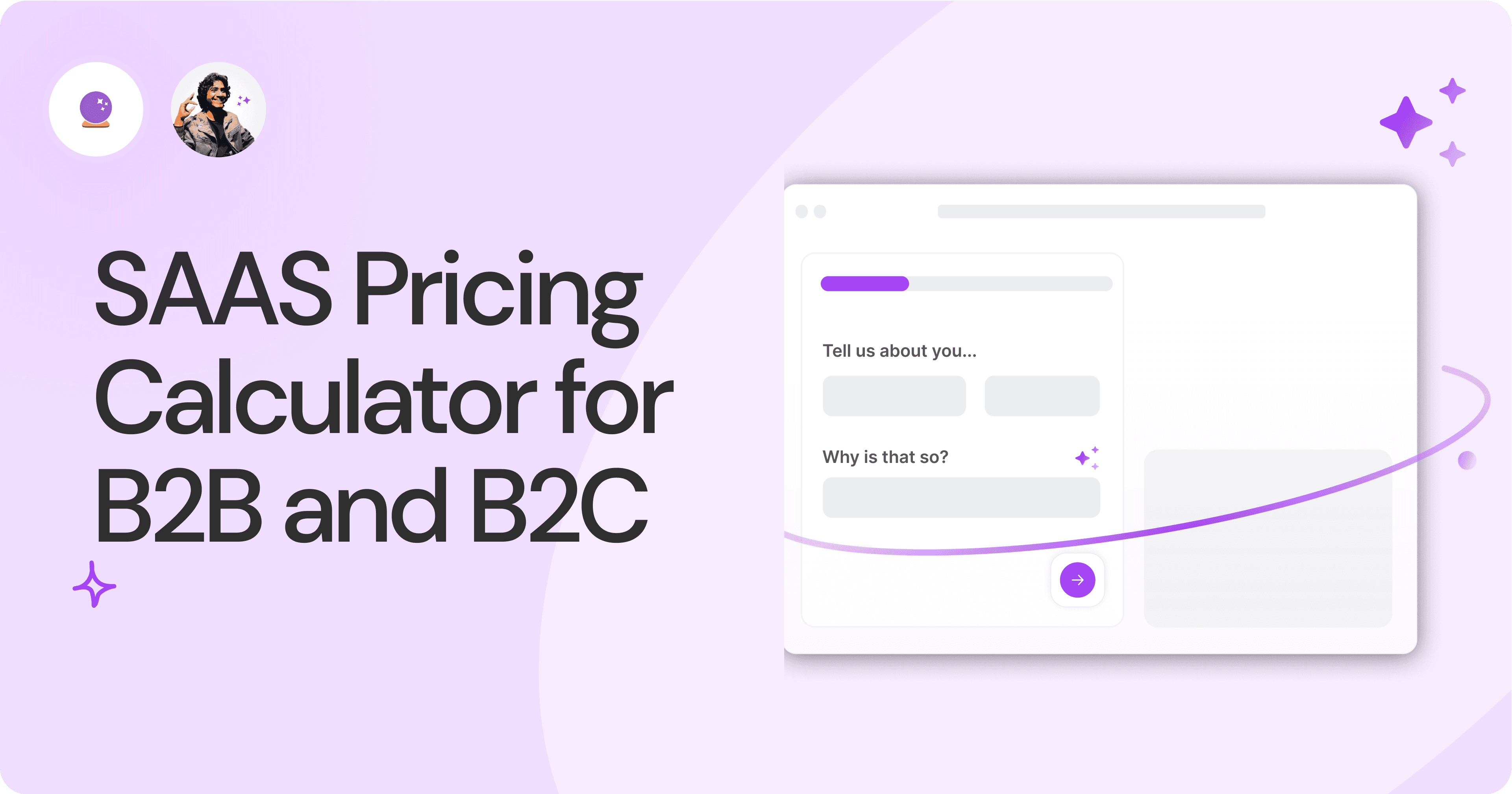
SAAS Pricing Calculators: B2B v B2C Online Forms.
The SaaS pricing calculator is an essential tool for both B2B and B2C SaaS companies. But how do you build it, right? We have you covered.
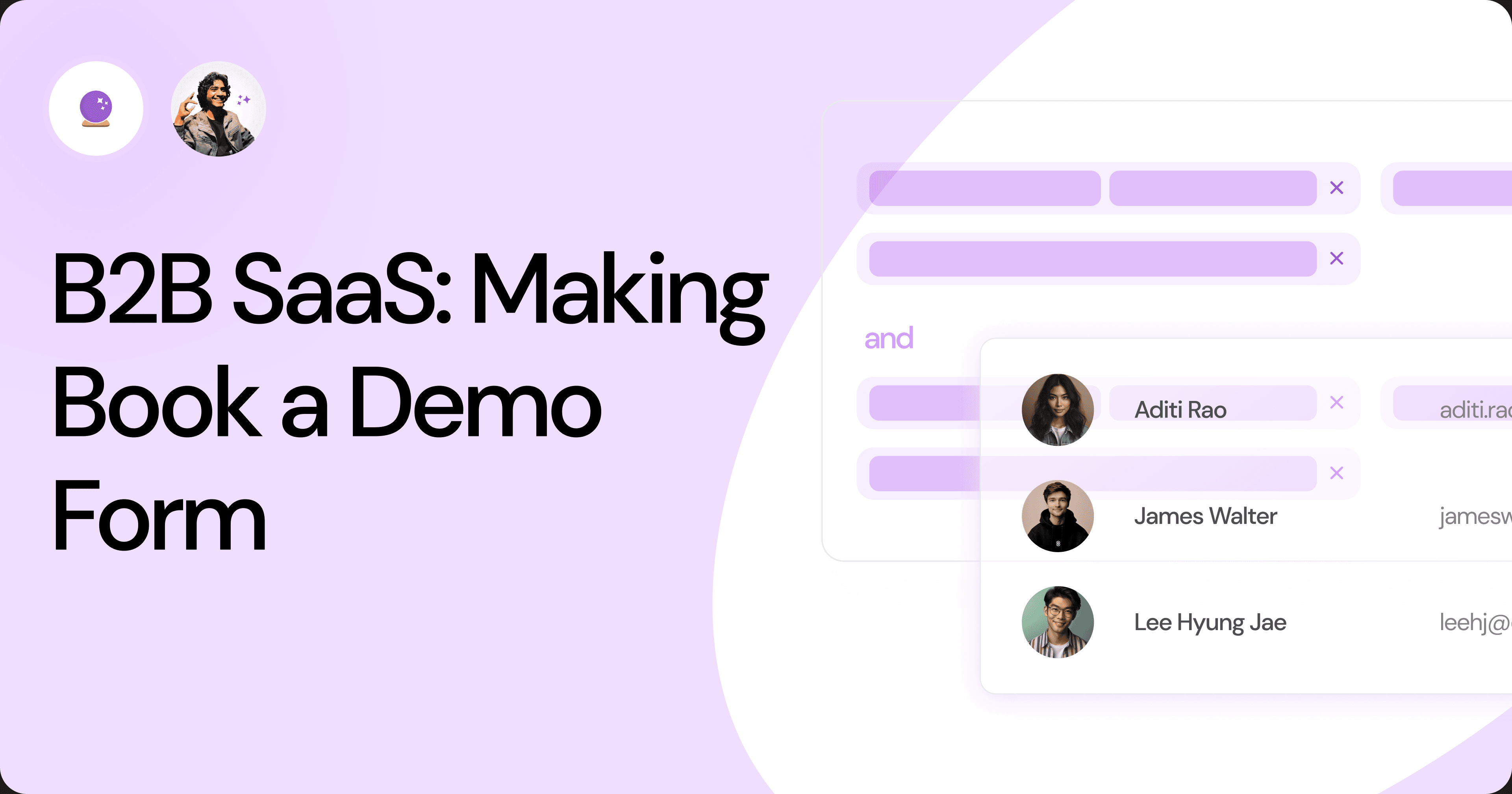
B2B SaaS: Making Book a Demo Form.
Having the perfect book a demo form for B2B SaaS is the first step in capturing leads. There are a few fundamental techniques to get this form right. Read on.

How to Get Started With SaaS Onboarding.
SaaS onboarding is essential for customer onboarding in B2B and B2C SaaS. Let’s understand its fundamentals, including the metrics.
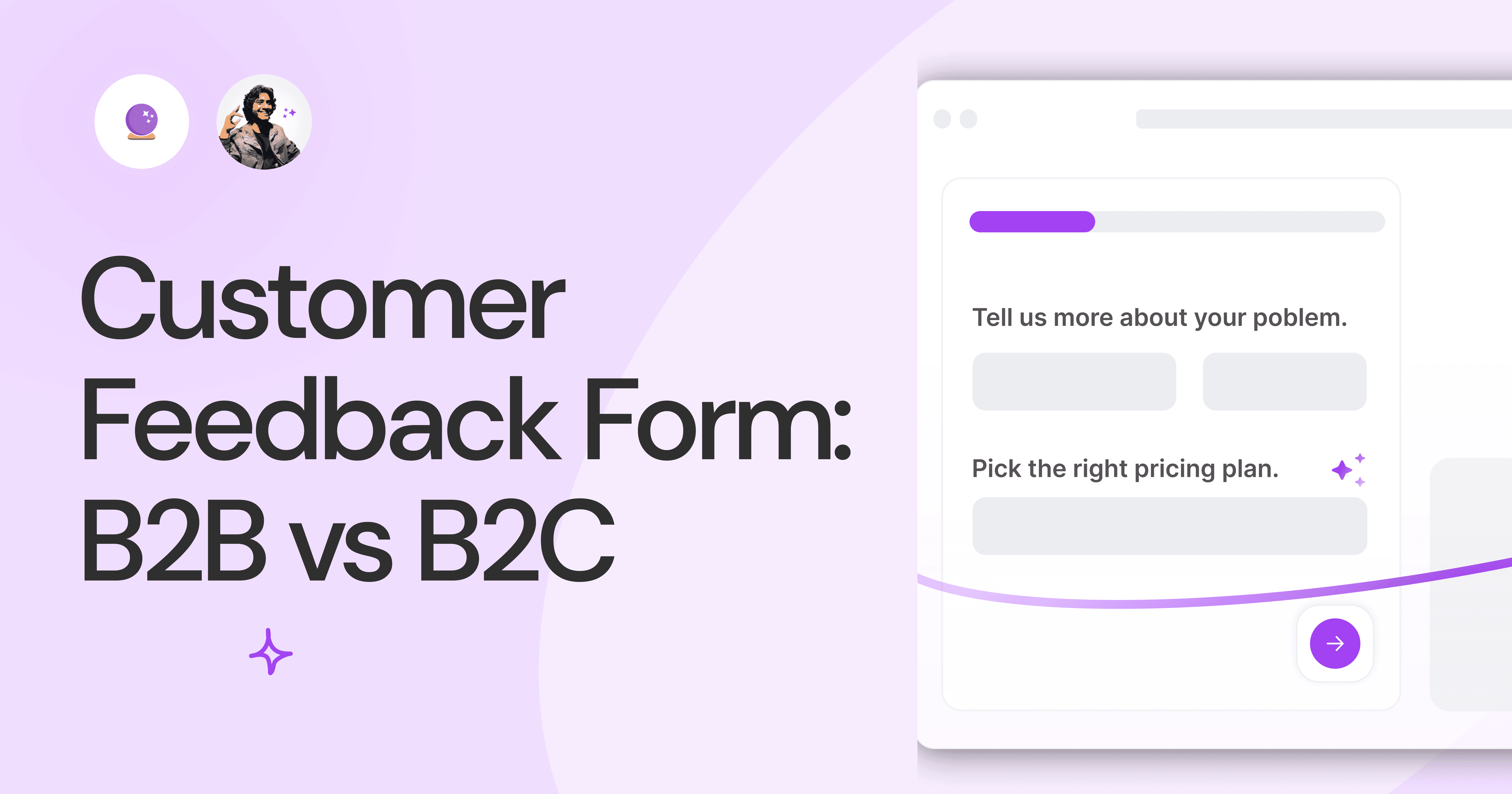
Customer Feedback Form: B2B vs B2C.
Why is customer feedback important? Because it dictates progress on B2B and B2B products and services for the customer to meet their goals.

SaaS Customer Feedback Form: 6 Main Types.
As much as SaaS is self-serve, the role of a customer feedback form is highly relevant. There are different types, each with its use case and sections.
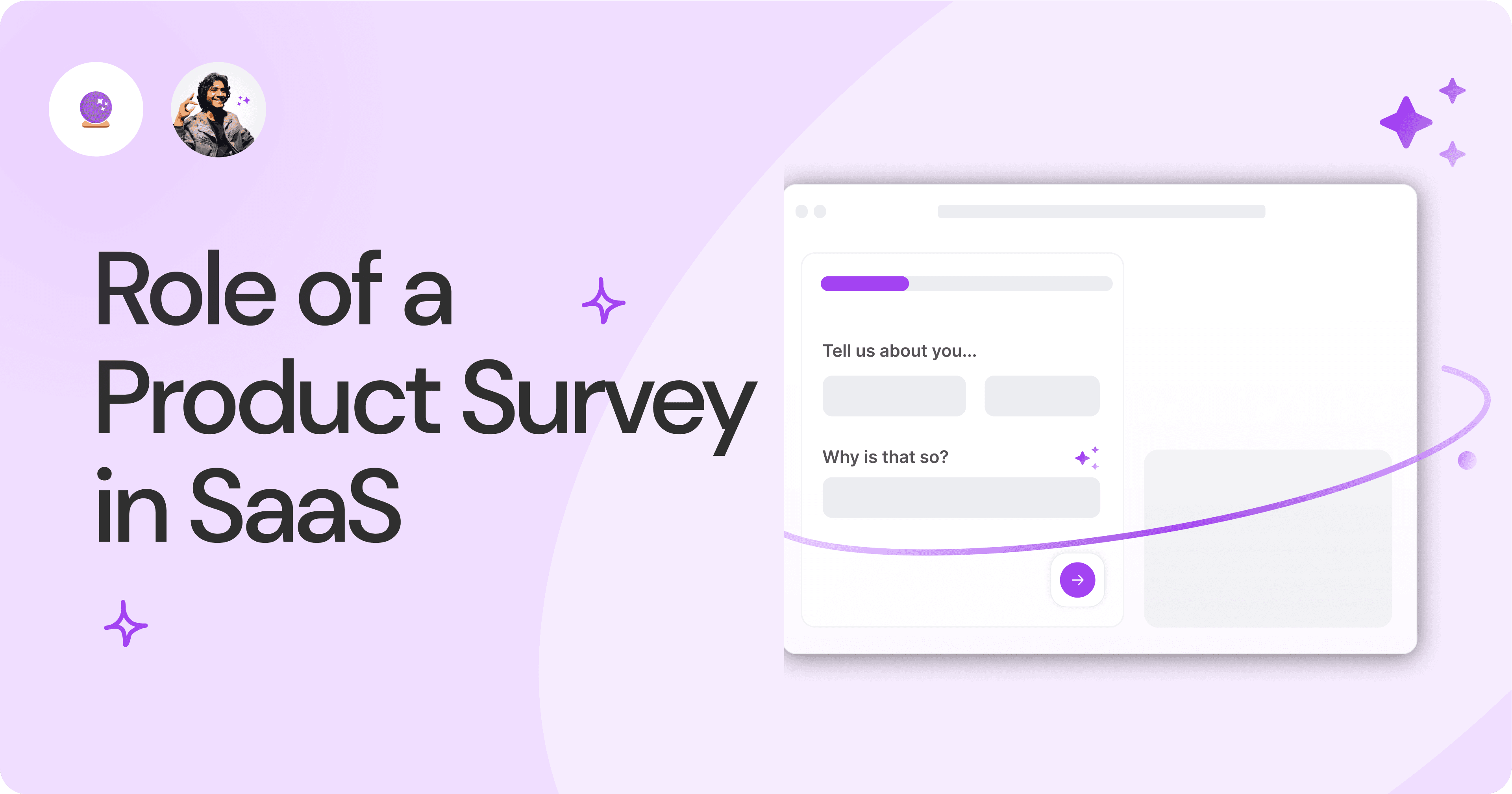
Role of a Product Survey in SaaS.
SaaS is all about creating products for specific use cases. This is where a product survey becomes all the more important to know the user deeply.

Should You Do a SaaS Market Survey?
Every SaaS company wants to grow fast. But without a market survey, growth isn't possible or sustainable. Let’s see how to do a market survey.

SAAS Pricing Calculators: B2B v B2C Online Forms.
The SaaS pricing calculator is an essential tool for both B2B and B2C SaaS companies. But how do you build it, right? We have you covered.

B2B SaaS: Making Book a Demo Form.
Having the perfect book a demo form for B2B SaaS is the first step in capturing leads. There are a few fundamental techniques to get this form right. Read on.

How to Get Started With SaaS Onboarding.
SaaS onboarding is essential for customer onboarding in B2B and B2C SaaS. Let’s understand its fundamentals, including the metrics.

Customer Feedback Form: B2B vs B2C.
Why is customer feedback important? Because it dictates progress on B2B and B2B products and services for the customer to meet their goals.

SaaS Customer Feedback Form: 6 Main Types.
As much as SaaS is self-serve, the role of a customer feedback form is highly relevant. There are different types, each with its use case and sections.

Role of a Product Survey in SaaS.
SaaS is all about creating products for specific use cases. This is where a product survey becomes all the more important to know the user deeply.

Should You Do a SaaS Market Survey?
Every SaaS company wants to grow fast. But without a market survey, growth isn't possible or sustainable. Let’s see how to do a market survey.

SAAS Pricing Calculators: B2B v B2C Online Forms.
The SaaS pricing calculator is an essential tool for both B2B and B2C SaaS companies. But how do you build it, right? We have you covered.

B2B SaaS: Making Book a Demo Form.
Having the perfect book a demo form for B2B SaaS is the first step in capturing leads. There are a few fundamental techniques to get this form right. Read on.

How to Get Started With SaaS Onboarding.
SaaS onboarding is essential for customer onboarding in B2B and B2C SaaS. Let’s understand its fundamentals, including the metrics.

Customer Feedback Form: B2B vs B2C.
Why is customer feedback important? Because it dictates progress on B2B and B2B products and services for the customer to meet their goals.

SaaS Customer Feedback Form: 6 Main Types.
As much as SaaS is self-serve, the role of a customer feedback form is highly relevant. There are different types, each with its use case and sections.

Role of a Product Survey in SaaS.
SaaS is all about creating products for specific use cases. This is where a product survey becomes all the more important to know the user deeply.

Should You Do a SaaS Market Survey?
Every SaaS company wants to grow fast. But without a market survey, growth isn't possible or sustainable. Let’s see how to do a market survey.

Nine Types of Healthcare and Medical Forms.
Medical forms are a must-have for any healthcare business or practitioner. Learn about the different kinds of medical and healthcare forms.

4 Tips for Better Medical History Forms.
Medical history forms are central to patient care, onboarding, and medical administration records. Learn how to make them easier to fill.

How to Build Mental Health Intake Forms?
Mental health intake forms are not like patient intake forms. Mental health intake forms deal with far more sensitive data and have specific design methods.

What, Why and How of Telemedicine Forms.
Telemedicine is on the rise and with different form builders out there, which one best suits your needs as a healthcare services provider?

3 Reasons for Major Drop-Offs in Medical Forms.
No matter which healthcare form we pick, there are major drop-off reasons. We shall dive into the top 3 and learn how to resolve them in your next form.

Patient Onboarding Forms - From Click to Clinic.
Patient onboarding forms are the first touchpoint for patients; getting this right for higher conversion rates is a must-have. Learn how to perfect them now.

5 Key Parts of a Good Patient Satisfaction Form.
The goal of patient satisfaction surveys is to course-correct the services of a healthcare provider. Patient feedback leads to a culture of patient-centric care.

Build Quick and Easy Medical Release Forms.
Every HIPAA-compliant healthcare provider comes across medical release forms that involve details from medical history forms. Can they be shipped fast? Yes.

SAAS Pricing Calculators: B2B v B2C Online Forms.
The SaaS pricing calculator is an essential tool for both B2B and B2C SaaS companies. But how do you build it, right? We have you covered.

B2B SaaS: Making Book a Demo Form.
Having the perfect book a demo form for B2B SaaS is the first step in capturing leads. There are a few fundamental techniques to get this form right. Read on.

How to Get Started With SaaS Onboarding.
SaaS onboarding is essential for customer onboarding in B2B and B2C SaaS. Let’s understand its fundamentals, including the metrics.

Customer Feedback Form: B2B vs B2C.
Why is customer feedback important? Because it dictates progress on B2B and B2B products and services for the customer to meet their goals.

SaaS Customer Feedback Form: 6 Main Types.
As much as SaaS is self-serve, the role of a customer feedback form is highly relevant. There are different types, each with its use case and sections.

Role of a Product Survey in SaaS.
SaaS is all about creating products for specific use cases. This is where a product survey becomes all the more important to know the user deeply.

Should You Do a SaaS Market Survey?
Every SaaS company wants to grow fast. But without a market survey, growth isn't possible or sustainable. Let’s see how to do a market survey.
Subscribe to stay updated.
Subscribe to stay updated.
Subscribe to stay updated.
HC

HC

HC

HC

70+ people from across industries read our emails.
HC

HC

70+ people from across industries read our emails.
HC

HC

HC

70+ people from across industries read our emails.




Bangalore, India / San Francisco, US
WorkHack Inc. 2023
Bangalore, India
San Francisco, US
WorkHack Inc. 2023
WorkHack Inc. 2023
Bangalore, India / San Francisco, US
WorkHack Inc. 2023
Bangalore, India / San Francisco, US



